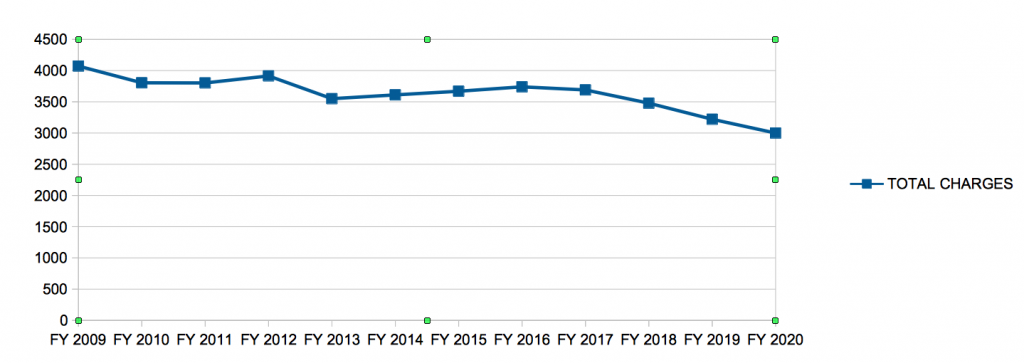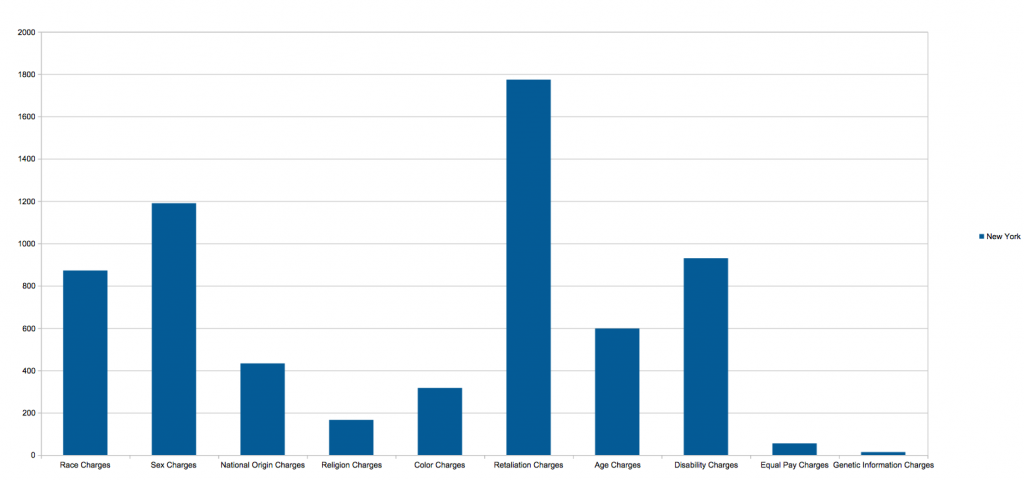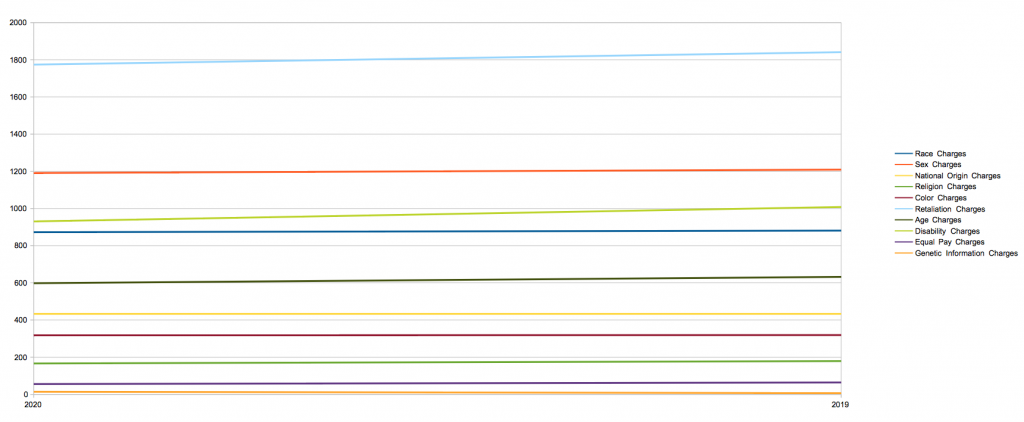The Equal Employment Opportunity Commission is the federal agency charged with investigating and regulating workplace discrimination. Before filing a lawsuit in court, employees must first file a charge with the EEOC. Each year, the EEOC tracks the cases filed by charge type, meaning the type of the discrimination the employee is alleging. The EEOC has published its 2020 employment discrimination statistics. Today’s Long Island employment law blog takes a closer look at the numbers, and in particular, we take a look at what’s happening in New York.
Overall, across the entire country and the EEOC’s jurisdiction, 67,448 charges were filed. Later, we’ll discuss that there may be factors to consider other than less employees are filing charges, but 2020 marks the fourth straight year of declining charges, and nearly a decade of an overall average decrease in total filings.
New York is following the national trend. In 2020, 2,999 charges were filed, down from 3,220 the year before. This is also the fourth year of declines. The following chart shows that, with the exception of a few upward ticks, the trend has generally been less and less filings since the reporting started in 2009.

Total New York EEOC Charge Filings from 2009 to 2020
Retaliation is by far the number one charge type. But, the numbers here can be deceiving. Retaliation frequently comes along with an employee complaining about some other type of underlying discrimination. In other words, many times, an employee will complain that she is facing sex discrimination in the workplace. After complaining internally to the employer, the employer may retaliate and fire the employee. When the employee files a charge of discrimination with the EEOC, she will charge both sex discrimination and retaliation. Thus, the raw number of retaliation charges does not necessarily reflect an independent charge of retaliation. The charge will often include retaliation plus one more categories of discrimination. Nonetheless, with 1,774 retaliation charges making up almost 60% of EEOC charges in New York, retaliation continues to prove itself to be a dangerous weapon for employees and a pitfall for employers.
After retaliation charges, sex, race, and disability charges lead the way. With the me-too movement and all the publicity about workplace sexual harassment in recent years, it’s not surprising that sex discrimination is the second highest type of charge of discrimination filed with the EEOC in New York, at 1,190 charges. This is a slight decrease from the 2019 numbers when 1209 sex discrimination charges were filed. In fact, except national origin charges which were exactly the same from 2019 to 2020, all charge types decreased, except Genetic Information discrimination, which saw a small uptick from 6 in 2019 to 14 in 2020. The next two charts shows the 2020 EEOC charge numbers in New York, and the change between 2019 and 2020.

2020 EEOC Charges in NY by charge type

2019 vs 2020 NY EEOC Charges by Type
What do the 2020 numbers tell us about what’s happening with workplace discrimination in New York? The numbers this year are tricky because of many factors. First, and perhaps most obviously, in 2020, New York workplaces were facing the pandemic. New York’s pause shutdown workplaces across the state for months, taking away opportunity for hostile work environments, sexual harassment, and other discriminatory conduct. Would the charge numbers have been on a higher trajectory if workplaces had not shut down? It’s certainly impossible to say, but as noted, charges have been declining for about a decade and continued declining in 2018 and 2019, when the me-too movement was in the forefront. This suggests the numbers would have declined, even absent the pandemic.
But, other non-pandemic factors may reveal why EEOC charges are declining. The EEOC’s statistics do not include charges filed with state or local enforcement agencies, although in New York, charges filed locally are cross-filed with the EEOC. In New York, local county or city human rights commissions are also empowered to investigate charges of discrimination, as is the New York State Division of Human Rights. Oftentimes, state or local workplace discrimination laws are more liberal and expansive than the federal countertops. This is the case in New York, where New York City’s human rights laws have been liberally construed for years, and New York State last year revised its workplace discrimination laws to largely match the City’s. Thus, it is often more advantageous for employees to file in the New York State Division of Human Rights instead of the EEOC, so their claims are viewed with the benefit of New York’s liberal human rights laws. This factor may explain the overall decline of EEOC filings over the past decade. To test this theory, we’ll take a look at the Division’s numbers when they’re published.
Of course, another factor may be that workplaces are paying closer attention to anti-discrimination training and policies. New York law now requires that employers train employees about sexual harassment and discrimination. If those trainings and policies are effective, we would expect to see a decrease in unlawful employment practices, and thus, a decease in discrimination charges.
What do you think about the latest EEOC statistics? Let us know on our Facebook page. If you have questions about the EEOC, New York State Division of Human Rights, workplace discrimination, or retaliation, contact a Long Island employment lawyer at 631-352-0050. We are now serving New York’s Hudson Valley, as well, and our Hudson Valley employment attorneys are available at 845-669-0040.
 Long Island Employment Law Blog
Long Island Employment Law Blog

